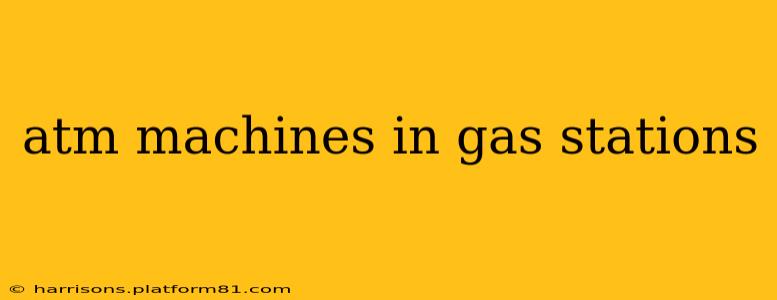Gas stations have become ubiquitous hubs of convenience, offering not only fuel but also snacks, drinks, and increasingly, ATM machines. The presence of ATMs at gas stations provides a valuable service to drivers and local communities, but it also raises questions about security, accessibility, and the evolving landscape of financial services. This article delves into the multifaceted world of ATMs in gas stations, addressing common questions and concerns.
Why are ATMs Located in Gas Stations?
The strategic placement of ATMs in gas stations is a win-win for both businesses and consumers. For gas stations, ATMs attract customers who might otherwise go elsewhere. The added revenue from ATM fees and increased foot traffic can significantly boost profitability. For consumers, the convenience is undeniable. ATMs located at gas stations provide readily accessible cash withdrawals, especially in areas with limited banking options or during off-hours. The high traffic volume at gas stations ensures a constant flow of potential ATM users.
Are ATMs in Gas Stations Safe?
Security is a primary concern when using any ATM, especially those located in high-traffic areas like gas stations. While gas station ATMs are generally safe, potential risks exist. Criminals might target these locations due to the potential for quick getaways. Therefore, it's crucial to remain vigilant and take precautions:
- Choose well-lit ATMs: Avoid using ATMs in dimly lit areas, especially at night.
- Be aware of your surroundings: Pay attention to anyone lurking nearby.
- Shield your PIN: Cover the keypad with your hand while entering your PIN.
- Report suspicious activity: Immediately report any suspicious behavior to gas station staff or law enforcement.
- Check for tampering: Before using the ATM, inspect it for signs of tampering or unusual attachments.
Many modern ATMs incorporate advanced security features, such as surveillance cameras and tamper-resistant casings. Gas station owners also take security seriously, often implementing measures such as improved lighting, security cameras, and regular maintenance checks.
How Do Gas Station ATMs Work?
Gas station ATMs function similarly to those located in banks or other locations. They are connected to a network of banks and financial institutions, allowing users to withdraw cash, check balances, and make other transactions using their debit or credit cards. The specific functions available will vary depending on the ATM provider and the bank issuing the user's card. Transactions are typically processed electronically, transferring funds from the user's account to the ATM.
What are the Fees for Using ATMs in Gas Stations?
ATM fees can vary significantly depending on the ATM provider, the user's bank, and the type of transaction. Gas stations often charge fees for cash withdrawals, especially for non-customers. Additionally, the user's own bank may also impose fees for using out-of-network ATMs. It's always advisable to check the ATM's screen for fee information before initiating a transaction to avoid unexpected charges.
What are the Benefits of Having ATMs at Gas Stations?
The benefits extend beyond mere convenience. For communities with limited banking access, gas station ATMs offer a crucial financial lifeline. They enable residents to access cash for essential needs, reducing the need to travel long distances to banks or other financial institutions. This is particularly beneficial for individuals who lack access to personal vehicles or rely on public transportation.
Are there any downsides to ATMs in gas stations?
While the convenience is clear, there are some downsides. The higher fees compared to in-bank ATMs can be a deterrent for some users. Also, the potential for security risks, though mitigated by various measures, always remains a concern. Lastly, the reliance on these ATMs could disproportionately impact those without bank accounts, reinforcing existing financial disparities.
The Future of ATMs in Gas Stations
With the rise of mobile payments and contactless transactions, the future of ATMs in gas stations remains somewhat uncertain. While their convenience continues to be valued, the long-term viability will depend on factors like evolving consumer preferences, technological advancements, and the ongoing competition from other financial service providers. However, the ongoing need for physical cash, especially in certain communities and for specific transactions, suggests that ATMs at gas stations will likely continue to play a significant role in the financial landscape for the foreseeable future.
